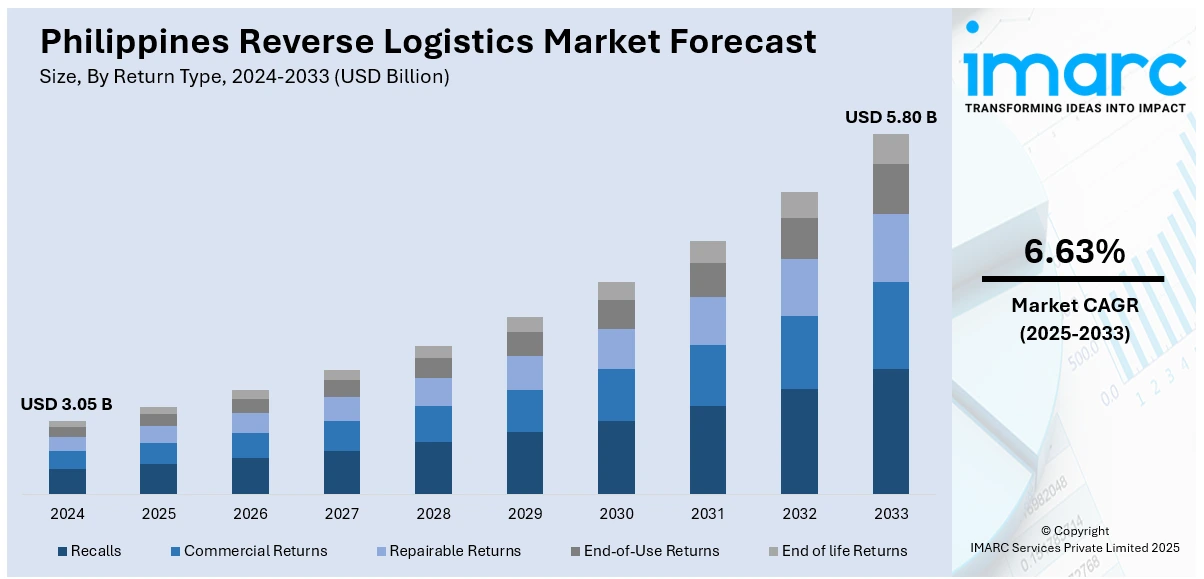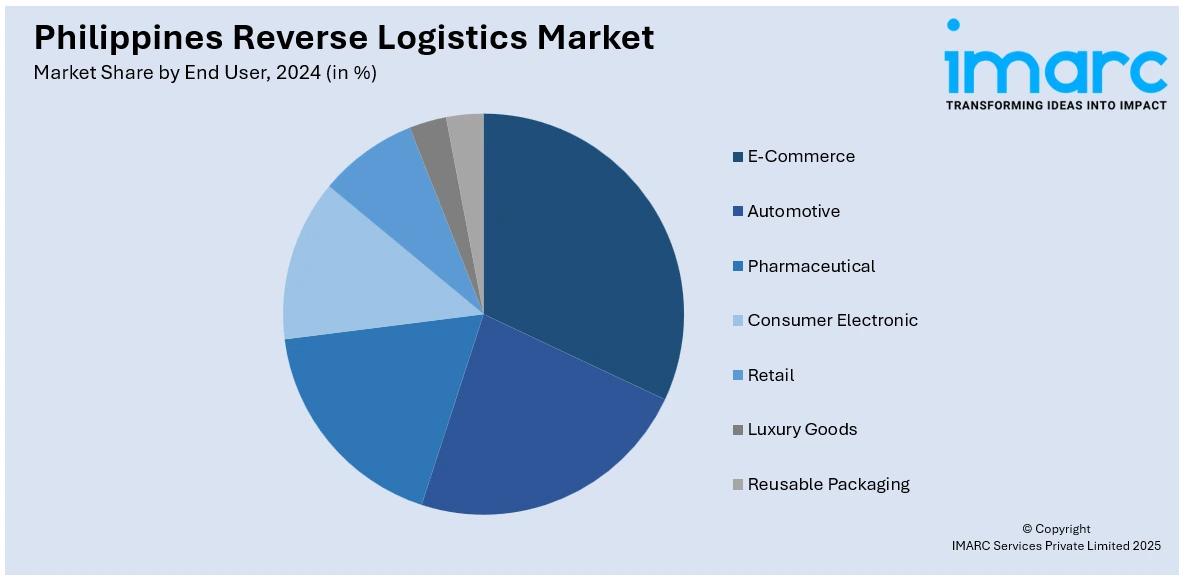
Philippines Reverse Logistics Market Size, Share, Trends and Forecast by Return Type, Service, End User, and Region, 2026-2034
Philippines Reverse Logistics Market Overview:
The Philippines reverse logistics market size reached USD 3.05 Billion in 2025. The market is projected to reach USD 5.80 Billion by 2034, exhibiting a growth rate (CAGR) of 6.63% during 2026-2034. The market is driven by rapid e-commerce growth, rising product returns, and increasing consumer demand for convenient return policies. Government regulations on waste management and extended producer responsibility encourage companies to adopt sustainable practices. Logistics innovations, digital platforms, and third-party providers improve efficiency in handling returns, repairs, and recycling. Additionally, growing environmental awareness pushes businesses to recover, refurbish, or recycle products. Cost-saving opportunities from resource recovery and competitive differentiation through sustainability further strengthen the Philippines reverse logistics market share.
|
Report Attribute
|
Key Statistics
|
|---|---|
|
Base Year
|
2025
|
|
Forecast Years
|
2026-2034
|
|
Historical Years
|
2020-2025
|
| Market Size in 2025 | USD 3.05 Billion |
| Market Forecast in 2034 | USD 5.80 Billion |
| Market Growth Rate 2026-2034 | 6.63% |
Philippines Reverse Logistics Market Trends:
Rapid Growth of E-commerce and Product Returns
The Philippines reverse logistics market growth is driven by the exponential expansion of the e-commerce sector, fueled by increasing internet penetration, mobile usage, and online shopping platforms, driven by increasing internet penetration, mobile usage, and online shopping platforms. With more consumers purchasing goods online, the rate of product returns has also surged, making reverse logistics essential. Customers expect hassle-free return policies, compelling retailers and logistics providers to establish efficient systems for product retrieval, inspection, and redistribution. Reverse logistics not only ensures customer satisfaction but also helps companies build trust and loyalty in a highly competitive online marketplace. As e-commerce continues expanding into rural areas, the complexity of managing reverse flows grows, pushing logistics firms to adopt digital tracking, last-mile innovations, and automated systems. Thus, the booming online retail environment directly fuels demand for structured reverse logistics networks to efficiently manage returns, exchanges, and resale of products while minimizing operational costs.

To get more information on this market, Request Sample
Environmental Regulations and Sustainability Initiatives
The Philippines generates around 2.7 million tons of plastic waste annually, with about 20% entering the ocean, underscoring the urgency for sustainable waste management. Government regulations, particularly the Extended Producer Responsibility (EPR) Act, mandate companies in manufacturing, retail, and consumer goods to recover and recycle increasing volumes of plastic packaging—starting at 20% in 2023 and rising to 80% by 2028. This legal framework compels businesses to establish robust reverse logistics systems for collection, sorting, and recycling, often through partnerships with third-party providers. At the same time, rising consumer environmental awareness pressures firms to adopt eco-friendly practices like refurbishing, reuse, and waste reduction. Beyond compliance, companies benefit from enhanced brand reputation, resource recovery, and alignment with global supply chain sustainability requirements. Consequently, regulations and sustainability commitments are accelerating the integration of reverse logistics infrastructure across Philippine industries.
Cost Savings and Value Recovery Opportunities
Reverse logistics is increasingly recognized as a cost-saving mechanism in the Philippines. By retrieving, refurbishing, repairing, or recycling returned products, companies reduce waste while recovering value from items that would otherwise be discarded. This creates opportunities to resell refurbished goods at lower price points, reaching cost-conscious consumers while minimizing losses. Businesses can also recover valuable materials such as metals, plastics, and electronic components for reuse in manufacturing, reducing dependence on new raw materials and lowering production costs. Additionally, reverse logistics helps optimize warehouse space, reduce disposal fees, and streamline supply chain efficiency. In industries like electronics, fashion, and consumer goods, value recovery directly contributes to profitability and sustainability. Companies that embrace reverse logistics as a revenue-generating and cost-control strategy gain a competitive advantage, making financial and operational benefits one of the key Philippines reverse logistics market trends.
Philippines Reverse Logistics Market Segmentation:
IMARC Group provides an analysis of the key trends in each segment of the market, along with forecasts at the country and regional levels for 2026-2034. Our report has categorized the market based on return type, service, and end user.
Return Type Insights:
- Recalls
- Commercial Returns
- Repairable Returns
- End-of-Use Returns
- End of life Returns
The report has provided a detailed breakup and analysis of the market based on the return type. This includes recalls, commercial returns, repairable returns, end-of-use returns, and end of life returns.
Service Insights:
- Transportation
- Warehousing
- Reselling
- Replacement Management
- Refund Management Authorization
- Others
A detailed breakup and analysis of the market based on the service have also been provided in the report. This includes transportation, warehousing, reselling, replacement management, refund management authorization, and others.
End User Insights:

- E-Commerce
- Automotive
- Pharmaceutical
- Consumer Electronic
- Retail
- Luxury Goods
- Reusable Packaging
The report has provided a detailed breakup and analysis of the market based on the end user. This includes e-commerce, automotive, pharmaceutical, consumer electronic, retail, luxury goods, and reusable packaging.
Regional Insights:
- Luzon
- Visayas
- Mindanao
The report has also provided a comprehensive analysis of all the major regional markets, which include Luzon, Visayas, and Mindanao.
Competitive Landscape:
The market research report has also provided a comprehensive analysis of the competitive landscape. Competitive analysis such as market structure, key player positioning, top winning strategies, competitive dashboard, and company evaluation quadrant has been covered in the report. Also, detailed profiles of all major companies have been provided.
Philippines Reverse Logistics Market News:
- In November 2024, Maersk opened its largest Philippine distribution center, a 24-acre facility in Calamba, Southern Luzon, with capacity for 76,000 pallets and 75 docks. Launched on November 4, 2024, it aims to decongest Metro Manila, cut logistics costs, and boost Calabarzon’s competitiveness. Serving industries from consumer goods to automotive, the hub targets LEED certification through sustainability initiatives. Maersk now operates about 100 warehouses nationwide.
- In October 2024, JD Logistics expanded its international express delivery to seven Southeast Asian countries, including the Philippines, covering nearly 30 countries with plans to reach 80 by year-end. The company, operating over 1,600 warehouses and employing 300,000 delivery personnel, continues to grow its supply chain and warehousing capabilities, including reverse logistics services. Recent expansions include a LEED-certified 10,000 m² warehouse in Malaysia, supporting B2B, B2C, and omni-channel fulfillment.
Philippines Reverse Logistics Market Report Coverage:
| Report Features | Details |
|---|---|
| Base Year of the Analysis | 2025 |
| Historical Period | 2020-2025 |
| Forecast Period | 2026-2034 |
| Units | Billion USD |
| Scope of the Report |
Exploration of Historical Trends and Market Outlook, Industry Catalysts and Challenges, Segment-Wise Historical and Future Market Assessment:
|
| Return Types Covered | Recalls, Commercial Returns, Repairable Returns, End-of-Use Returns, End of life Returns |
| Services Covered | Transportation, Warehousing, Reselling, Replacement Management, Refund Management Authorization, Others |
| End Users Covered | E-Commerce, Automotive, Pharmaceutical, Consumer Electronic, Retail, Luxury Goods, Reusable Packaging |
| Regions Covered | Luzon, Visayas, Mindanao |
| Customization Scope | 10% Free Customization |
| Post-Sale Analyst Support | 10-12 Weeks |
| Delivery Format | PDF and Excel through Email (We can also provide the editable version of the report in PPT/Word format on special request) |
Key Questions Answered in This Report:
- How has the Philippines reverse logistics market performed so far and how will it perform in the coming years?
- What is the breakup of the Philippines reverse logistics market on the basis of return type?
- What is the breakup of the Philippines reverse logistics market on the basis of service?
- What is the breakup of the Philippines reverse logistics market on the basis of end user?
- What is the breakup of the Philippines reverse logistics market on the basis of region?
- What are the various stages in the value chain of the Philippines reverse logistics market?
- What are the key driving factors and challenges in the Philippines reverse logistics market?
- What is the structure of the Philippines reverse logistics market and who are the key players?
- What is the degree of competition in the Philippines reverse logistics market?
Key Benefits for Stakeholders:
- IMARC’s industry report offers a comprehensive quantitative analysis of various market segments, historical and current market trends, market forecasts, and dynamics of the Philippines reverse logistics market from 2020-2034.
- The research report provides the latest information on the market drivers, challenges, and opportunities in the Philippines reverse logistics market.
- Porter's five forces analysis assist stakeholders in assessing the impact of new entrants, competitive rivalry, supplier power, buyer power, and the threat of substitution. It helps stakeholders to analyze the level of competition within the Philippines reverse logistics industry and its attractiveness.
- Competitive landscape allows stakeholders to understand their competitive environment and provides an insight into the current positions of key players in the market.
Need more help?
- Speak to our experienced analysts for insights on the current market scenarios.
- Include additional segments and countries to customize the report as per your requirement.
- Gain an unparalleled competitive advantage in your domain by understanding how to utilize the report and positively impacting your operations and revenue.
- For further assistance, please connect with our analysts.
 Request Customization
Request Customization
 Speak to an Analyst
Speak to an Analyst
 Request Brochure
Request Brochure
 Inquire Before Buying
Inquire Before Buying




.webp)




.webp)












